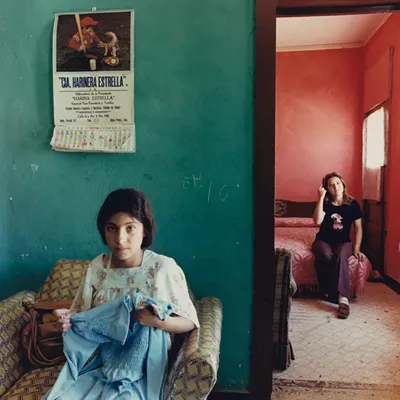Frida Kahlo's life famously alternated between prodigious artistic production and debilitating pain—between sun and shadow.
The Mexican painter spent much of her life confined to her bed, and she made many of her paintings flat on her back. But despite her travails, she found a way to turn traditional Mexican motifs into groundbreaking modernist art.
So Kahlo is a natural subject for Sombra y Luz (Shadow and Light), ZUZI! Dance Company's 14th annual solstice celebration. Timed to usher in the winter solstice on Dec. 22, the shortest and darkest day on the calendar, the show aims to pierce the December night with the light of dance and live music.
"The theme this year is visual art and dance," says artistic director Nanette Robinson. During the concert, paintings and photographs are projected onto the backdrop, while the ZUZI! dancers perform modern movements on the floor and in the air. A full band led by guitarist and singer Pablo Peregrina plays for many of the dances.
Robinson was partly inspired by Come Together, the Beatles show the troupe put on last spring.
"I was looking at art of the '60s for that show, and I started thinking: We'd never done anything on dance and visual art for the solstice show," she says.
Robinson nabbed Kahlo right away for her dance; other choreographers in the troupe picked the Renaissance painter Leonardo da Vinci, and a string of 19th-century Frenchmen, from Paul Delaroche and Jean-François Millet to Henri Rousseau.
"Blood and Gold," Robinson's dance about Kahlo, is the longest piece and the one with the most artwork; it also has spoken word and live music. Eleven dancers perform, variously dressed as the traditional Frida, in long skirts and rebozos, and as the broken Frida, with costumes evoking her splintered spine. The six segments trace Kahlo's life from her childhood and her near-fatal accident on a trolley at age 18, to her tempestuous marriage to Diego Rivera and the deterioration of her body. Projected slides picture some of her most-beloved paintings, including "The Two Fridas," "The Broken Column" and some of her many self-portraits.
Robinson relied on Frida: A Biography of Frida Kahlo, by Hayden Herrera, along with other source materials, as she did her research.
"I knew about her life," Robinson says, "but when I delved into it, I realized what an inspiration she is, what a role model for women."
Despite Kahlo's tragedies, the piece ends on an upbeat note. "She lived life in pain, but she had such joy in life."
The whole band performs—Peregrina on guitar, Bobby Ronstadt on accordion, Randy Omdahl and Bubba Fass on percussion, and Peregrina, Sally Withers and Jackie Hereford on vocals. The music includes an original song, "Blood and Gold," by Peregrina, as well as "La Llorona" by Alvaro Carrillo, and "Burn It Blue," composed by Elliot Goldenthal for the movie Frida.
The dance "Chiaroscuro," choreographed by Mechelle Flemming, literally looks at sun and shadow: The title is the word for the painterly practice of using extreme lights and darks. Created for the new Apprentice Company, the work is danced before a backdrop of a Leonardo sketch of hands, drawn in preparation for his well-known painting "Lady With an Ermine," circa 1489. The recorded music is a moody violin concerto by Philip Glass. Seven dancers perform the aerial work on a length of white silk.
Ekida Laurie's "Potato," for six dancers, including herself, is set to cello music by Ryuichi Sakamoto. Paintings of peasants by Millet heighten the food theme. "The Gleaners" is a beautifully composed 1857 oil that depicts poor women scavenging for leftover grain in a depleted field. "Woman With a Rake," from 1856-1857, zeroes in on an exhausted farmworker.
A dramatic 1855 painting by Delaroche, "La Jeune Martyre (The Young Martyr)," is projected during "The Holding," a Flemming dance for six. The artwork conjures up a young Christian woman being drowned in Rome's Tiber River. Sally Withers sings poetry by Flemming; additional instrumental music is by composer James Newton Howard. The music, Robinson says, is "romantic and spacious" to match the image.
A couple of dances rely on contemporary photography, rather than paintings out of art history. Wendy Joy, a former ZUZI! member returning as a guest artist after a four-year absence, chose "Scared," a photo by Dillon Schultz, to accompany her dance "Walking Through the Shadow of Darkness. " The photo captures light coming through a door at the end of a dark hallway. With 11 dancers, the piece is about a teen coping with serious cardiac illness, Robinson says, and the movement mimics the "pumping action of the heart and expanding in breath."
The dance "In the Wings," choreographed by Karyn Reim, uses photographs of winter scenes made by Reim and Stacey Simons. Reim and Flemming dance a duet to the music of Tara MacLean.
The nine young dancers of Many Limbs perform "The Edges of One of Many Circles" on the trapezes; the aerial dance was composed by Carie Schneider, new director of ZUZI's youth company. The music is by Fever Ray, and the art this time is short videos by the Brothers Quay.
The community dance, created in workshops by 15 nondancers in conjunction with company dancers, focuses on the theme of crossing the desert. ZUZI did an evening-length concert on the border in 2010, presenting dances about the difficulties suffered by migrants walking through the Arizona wilderness. This time, though, "crossing the desert" broadens into a metaphor for dealing with challenges of all sorts.
"Each person did writing about the times they had to 'cross the desert' in their life," Robinson says.
Robinson and Shari Aslaksen converted the workshop stories into the dance "Crossing the Sands," set to music by Djivan Gasparyan and Iki Levy. The accompanying painting is "The Sleeping Gypsy," a spare 1897 oil by Rousseau of a desert by night. A woman lies asleep in the sand; a lion stands above. The scene is surreal, but strangely calm, and the darkness of the night is dispelled by the light of the moon.











